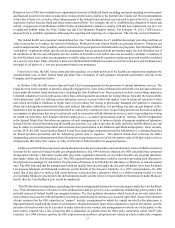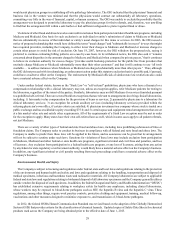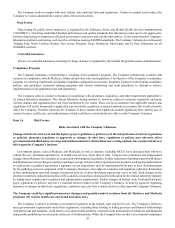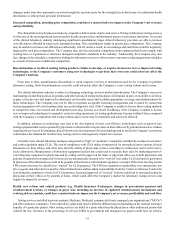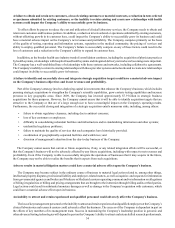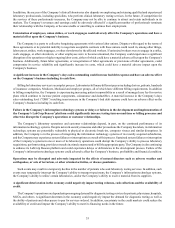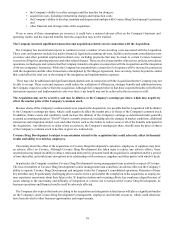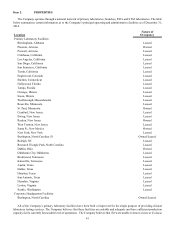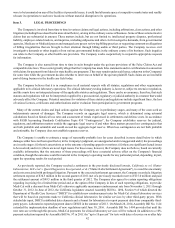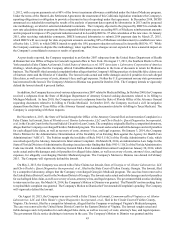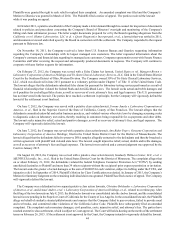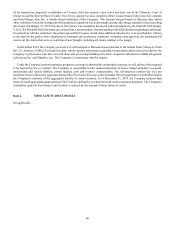LabCorp 2014 Annual Report Download - page 39
Download and view the complete annual report
Please find page 39 of the 2014 LabCorp annual report below. You can navigate through the pages in the report by either clicking on the pages listed below, or by using the keyword search tool below to find specific information within the annual report.37
dollar. The term loan credit facility was advanced in full on February 19, 2015, the date of the Company’s completion of the
acquisition.
On January 30, 2015, the Company issued $2.9 billion in debt securities, consisting of $500.0 million aggregate principal amount
of 2.625% Senior Notes due 2020, $500.0 million aggregate principal amount of 3.20% Senior Notes due 2022, $1.0 billion
aggregate principal amount of 3.60% Senior Notes due 2025 and $900.0 million aggregate principal amount of 4.700% Senior
Notes due 2045 (together, the “Acquisition Notes”). Net proceeds from the offering of the Acquisition Notes were $2,868.4 million
after deducting underwriting discounts and other estimated expenses of the offering. Net proceeds were used to pay a portion of
the cash consideration and the fees and expenses in connection with the Company’s acquisition of Covance. Pursuant to the bridge
facility commitment letter, upon the Company’s issuance of the Acquisition Notes the remaining $2.85 billion 364-day unsecured
debt bridge tranche under the senior unsecured bridge term loan credit facility was terminated.
On February 13, 2015, the Company entered into a 60-day cash bridge term loan credit facility in the principal amount of $400.0
million for the purpose of financing a portion of the cash consideration and the fees and expenses in connection with the transactions
contemplated by the Merger Agreement. The 60-day cash bridge term loan credit facility was entered into on the terms set forth
in the bridge facility commitment letter for the $400.0 million 60-day cash bridge tranche. The 60-day cash bridge term loan credit
facility was advanced in full on February 19, 2015, the date of the Company’s completion of the Acquisition.
The Company’s lower cash balance and increased indebtedness resulting from the acquisition financing could adversely affect
its business. In particular, it could increase the Company’s vulnerability to sustained, adverse macroeconomic weakness, limit
its ability to obtain further financing and limit its ability to pursue certain operational and strategic opportunities.
It may be difficult to integrate the business of Covance into the Company’s current business and the Company may fail
to realize the anticipated revenue growth expected from the transaction, which could adversely affect its operating results
and the market price of its common stock.
If the Company experiences greater than anticipated costs to integrate Covance Drug Development into its existing operations
or is not able to achieve the anticipated benefits of the acquisition, its business and results of operations could be negatively
affected. In addition, it is possible that the ongoing integration process could result in the loss of key employees, errors or delays
in systems implementation, the disruption of the Company’s ongoing business or inconsistencies in standards, controls, procedures
and policies that adversely affect the Company’s ability to maintain relationships with customers and employees or to achieve
the anticipated benefits of the acquisition. Integration efforts also may divert management attention and resources.
These integration matters may have an adverse effect on the Company, particularly during any transition period. In addition,
although Covance Drug Development is subject to many of the same risks and uncertainties that the Company faces in its business,
the acquisition of Covance also involves the Company entering new product and services areas, markets and industries, which
presents risks resulting from the Company’s relative inexperience in these new areas. Covance business’s laboratory testing business
could react differently to economic and other external factors than the Company’s. The Company faces the risk that it will not be
successful with these new products and services or in these new markets.
The success of the transaction will depend, in significant part, on the Company’s ability to successfully integrate the acquired
business and realize the anticipated benefits to be derived from incorporating Covance Drug Development into its operations.
The Company believes that the acquisition will provide an opportunity for revenue growth in development and commercialization
of drugs and diagnostics, nutritional analysis and other areas, including a number of new business areas for the Company. Actual
revenue growth, if any, may be lower than the Company expects and may take longer to achieve than anticipated, and expenses
may be higher than the Company expects. If the Company is not able to achieve the anticipated benefits of the acquisition, the
value of its common stock may be adversely affected.
The Company has made certain assumptions relating to the Covance acquisition that may prove to be materially inaccurate.
The Company has made certain assumptions relating to the Covance acquisition that may prove to be materially inaccurate,
including as a result of the failure to realize the expected benefits of the acquisition, a longer acquisition and transition process
than expected, higher than expected transaction and integration costs and unknown liabilities, or general economic and business
conditions that could adversely affect the combined company following the acquisition. These assumptions relate to numerous
matters, including:
• the Company’s assessments of the asset quality and value of Covance and its assets;
• projections of the business and Covance Drug Development's future financial performance;


